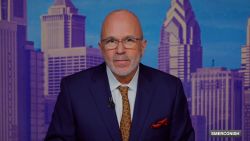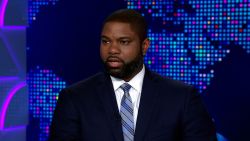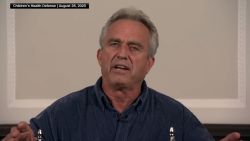Former Vice President Mike Pence’s role in certifying Joe Biden’s 2020 election win over Donald Trump and his repeated refusals to help the former president overturn the results, was under a microscope in special counsel Jack Smith’s detailed court filing Wednesday.
Smith, in the 165-page document, provides the fullest accounting yet of evidence in his 2020 election conspiracy case against Trump, Pence’s former boss. Within its pages, the document provides a detailed recounting of the hours leading up to the US Capitol riot and the deterioration of the relationship between the two men that led crowds of Trump supporters to call for violence against Pence.
The filing lands in the homestretch of the 2024 presidential race, as Vice President Kamala Harris’ campaign seeks to draw focus back on Trump’s refusal to accept his 2020 election loss.
The role that Trump’s vice president is playing in federal prosecution against him has always been one of the most remarkable things about Smith’s case. But a ruling over the summer by the Supreme Court, which granted Trump sweeping immunity for official actions but left the door open for prosecutors to pursue him for unofficial steps he took, also explains why those interactions make a hefty part of the historic new brief.
While the Supreme Court did not fully strip away allegations against Trump related to Pence from the case, the conservative majority indicated that it was skeptical that Trump’s conduct toward Pence could be prosecuted. Addressing the allegations that Trump pressured Pence to disrupt Congress’ certification, the high court deemed that conduct a “presumptively immune” official act and set a high bar for prosecutors to clear if they wanted to keep it in their case.
Smith, in an attempt to clear that hurdle, went into granular detail about the circumstances around various Trump-Pence conversations – where they occurred, who else was there and what each party said – to argue that those interactions were beyond immunity as they could serve no executive function.
At least some of that evidence came from Pence’s book, according to footnotes, while other pieces came from his contemporaneous notes and likely other non-public sources, including perhaps his own grand jury testimony.
During Tuesday evening’s vice presidential debate, Harris’ running mate, Gov. Tim Walz, repeatedly pressed Trump’s current running mate, Sen. JD Vance, on the January 6, 2021, insurrection and raised Pence’s role to ask: “Where is the firewall with Donald Trump?”
“Where is the firewall if he knows he can do anything, including taking an election?” Walz asked. “Will you stand up? Will you keep your oath of office even if the president doesn’t?”
During a rally in York, Pennsylvania, Wednesday evening, Walz made clear that the Harris campaign will lean on Smith’s filing as it seeks to bolster its claims that Trump is unfit for office.
“There is a reason Mike Pence was not on that stage with me,” Walz said. “I served with Mike Pence in Congress. We disagreed on most issues, but in Congress and as a vice president, I never criticized Mike Pence’s ethics and commitment to this country, and he made the decision for the Constitution,” Walz said.
Pence tried to console Trump after election
Smith’s team in the filing attempted to cast Pence’s communications with Trump outside of his official vice presidential duties by framing a series of interactions between the two as conversations between “running mates” and friends, where Pence looked to console Trump and urged him to accept his electoral defeat in the weeks following the election.
On November 7, when many outlets called the 2020 election for Biden, Pence allegedly “tried to encourage” the defendant “as a friend,” according to prosecutors. He told Trump that he should focus on how he revived the Republican Party and “gave it a new lease on life.”
At a November 12 lunch, Pence told Trump that he didn’t have to concede but he could “recognize process is over,” prosecutors said. And four days later at another lunch, Pence again tried to get Trump to accept the results and suggested running again in 2024, the filing says. Trump, though, responded: “I don’t know, 2024 is so far off.”
And during a November 23 phone call, Trump allegedly told Pence that one of his private attorneys was skeptical about the election challenges.
During a December 21 private lunch, prosecutors say Pence “encouraged” Trump “not to look at the election ‘as a loss – just an intermission.’” Later that day, Trump asked Pence during a private discussion in the Oval Office what they should do, to which Pence said, “After we have exhausted every legal process in the courts and Congress, if we still came up short, [Trump] should ‘take a bow.’”
The file also details how Pence relayed to Trump responses from the governors of Arizona and Georgia, who told him they “did not report evidence of fraud in the elections in their states” and “could not take actions to convene their states.” Trump disregarded his running mate, prosecutors say.
Increased pressure on Pence
Trump, after Pence told him he did not have the authority to decertify the election, began to up the intensity of his request, prosecutors say.
Prosecutors cite contemporaneous notes written by Pence – that allegedly show Trump and his co-conspirators “plotted to manipulate” the then-vice president about his role in the election certification process in the lead up to January 6.
Trump personally asked one of his co-conspirators, John Eastman, to explain to Pence why he should reject the official Electoral College votes on January 6. Pence took notes during that meeting, Smith says, which allegedly memorialized Trump saying that “when there’s fraud the rules get changed” and “this whole thing is up to MP.”
“[H]as to do w/you – you can be bold,” Pence’s notes allegedly say.
While Trump began to “directly and repeatedly” pressure Pence, his co-conspirators worked to orchestrate the pressure campaign behind the scenes, Smith says.
On January 1, Trump called Pence to berate him for filing a brief opposed to a suit brought by Trump and his allies that sought to force Pence to help throw the election to Trump, prosecutors say. On the call, Trump told Pence that “hundreds of thousands” of people “are gonna hate your guts” and “people are gonna think you’re stupid,” also calling Pence “too honest,” according to the filing.
Hours before January 6
On January 5, 2021, according to the filing, Trump once again met with Pence to allegedly try to pressure him not to certify the electoral college votes. It was in that meeting that Trump threatened to criticize Pence publicly, Smith wrote, citing Pence’s book.
Smith says that Pence told someone identified in the filing only as “P8” about that comment, and that “P8” was so concerned by the prospect that he alerted Pence’s Secret Service detail.
Trump tried again to pressure Pence on the morning of January 6, shortly before driving to deliver his speech at the Ellipse, prosecutors say.
Pence, however, again refused and Trump “was incensed,” the filing states.
It was then that Trump “set into motion the last plan in furtherance of his conspiracies: if Pence would not do as he asked, [Trump] needed to find another way to prevent the certification of Biden as president,” according to the filing.
“So on January 6, [Trump] sent to the Capitol a crowd of angry supporters, whom the defendant had called to the city and inundate with false claims of outcome-determinative election fraud, to induce Pence not to certify the legitimate electoral votes and to obstruct the certification,” the filing states.
According to prosecutors, Trump also showed his “desperate conduct as a candidate rather than a President” when rioters stormed the Capitol, forcing Pence to be moved to a secure location.
An unnamed White House aide, according to the filing, ran to Trump when he received a phone call that Pence had been taken to a secure location “in hopes that [Trump] would take action to ensure Pence’s safety.”
Trump, however, according to prosecutors, looked at the aide and simply replied, “So what?”
Trump tweeted infamous attack on Pence himself, prosecutors say
Trump personally posted on Twitter as the riot unfolded at the Capitol, saying that Pence “didn’t have the courage” to overturn the election results, according to prosecutors.
At the time he posted the tweet, prosecutors say, Trump knew his request for Pence to block the Electoral College votes was illegal, knew that his supporters gathered in Washington, DC, believed his lies during his speech at the Ellipse that the election had been stolen, and knew that those supporters had now breached the Capitol building.
“It was at that point — alone, watching news in real time, and with knowledge that rioters had breached the Capitol building — that the defendant issued the 2:24 p.m. Tweet attacking Pence for refusing the defendant’s entreaties to join the conspiracy and help overturn the results of the election,” Smith wrote.
The tweet communicated “to his angry supporters that Pence had let him — and them — down,” Smith wrote, adding that it was “not a message sent to address a matter of public concern and ease unrest; it was the message of an angry candidate upon the realization that he would lose power.”
A rioter at the Capitol used a bullhorn to read out the post, according to the filing. One minute after the Tweet was posted, Smith wrote, the Secret Service was forced to evacuate Pence to a secure location in the Capitol.
Some of those inside the Capitol then later began chanting, “Hang Mike Pence!,” “Where is Pence? Bring him out!” and “Traitor Pence!”
CNN’s Katelyn Polantz, John Fritze, Devan Cole and Marshall Cohen contributed to this report.


























